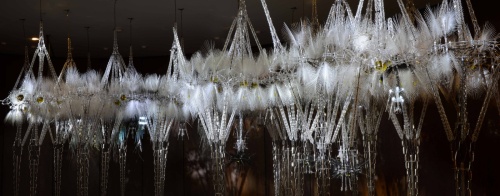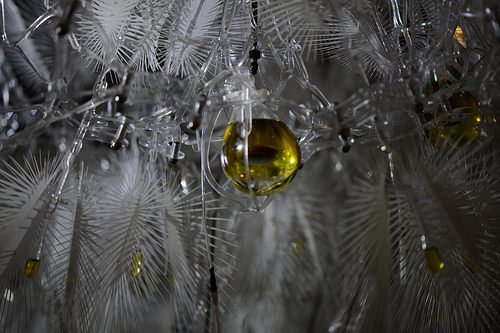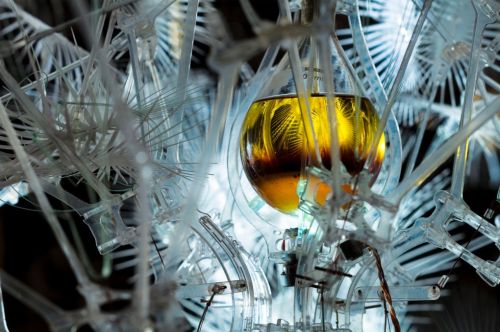
Sentient Chamber, 2015, Philip Beesley Architect and Living Architecture Systems Group
I’ve written before about Philip Beesley’s immersive installations, so I was delighted to learn that the National Academies of Science was bringing one to their headquarters in Washington, DC. Last week, I had the opportunity to see it on a special tour with Beesley, and to hear him speak on a panel at NAS that night. The installation is called Sentient Chamber, and it looks a bit like a cross between an open-air tent-style church and a ghostly Rose Parade float. Beesley describes it as an “experimental architecture and sculpture installation [which] acts as a test-bed for ongoing research that combines the disciplines of architecture and visual art, computer science and engineering, and synthetic biology.” It’s silver and white, and as you come close it clanks and beeps in a friendly way, shimmying its fronds and extending slender robotic fingers.
The main structure consists of a flexible grid made up of many triangular shaped elements in metal and plastic. Beesley explains that the shapes of the structure are based on hyperbolic geometry, which creates maximum strength from minimum materials. Above and among the arches are clusters of “acoustic and kinetic mechanisms” – microprocessor-driven fronds and branches that reach out and whirr and clank and light up when people interact with them. Fruit-like clumps of glass globes and tubes contain what Beesley describes as “the beginnings of a synthetic biology system” – oils that react to each other and to changes in the environment.

Detail view from Sentient Chamber
Beesley is an amazing talker, ranging from the concept of a structure as a box or a “raindrop” to metal-rod cores and distributed mechatronics within a single breath. But he returns often to a central theme – the idea of a new approach to shelter that is gentle and designed to be responsive to and integrated with nature, rather than an attempt to keep natural forces at bay with thick walls and high-tech climate-control systems.
He dreams rather about building gathering places that breathe, that learn, that welcome both humans and nature, and that are resource-positive – that is, generating energy and other resources rather than just conserving them. Although his Sentient Chamber at NAS is not ready to live in – it’s full of fragile pieces and there are laptops nestled in the treetops – it conjures up tantalizingly novel ideas about how we could live in the future. If you can, go see it now.
Filed under: The Art of Science Tagged: Art, National Academy of Sciences, Philip Beesley, science art

